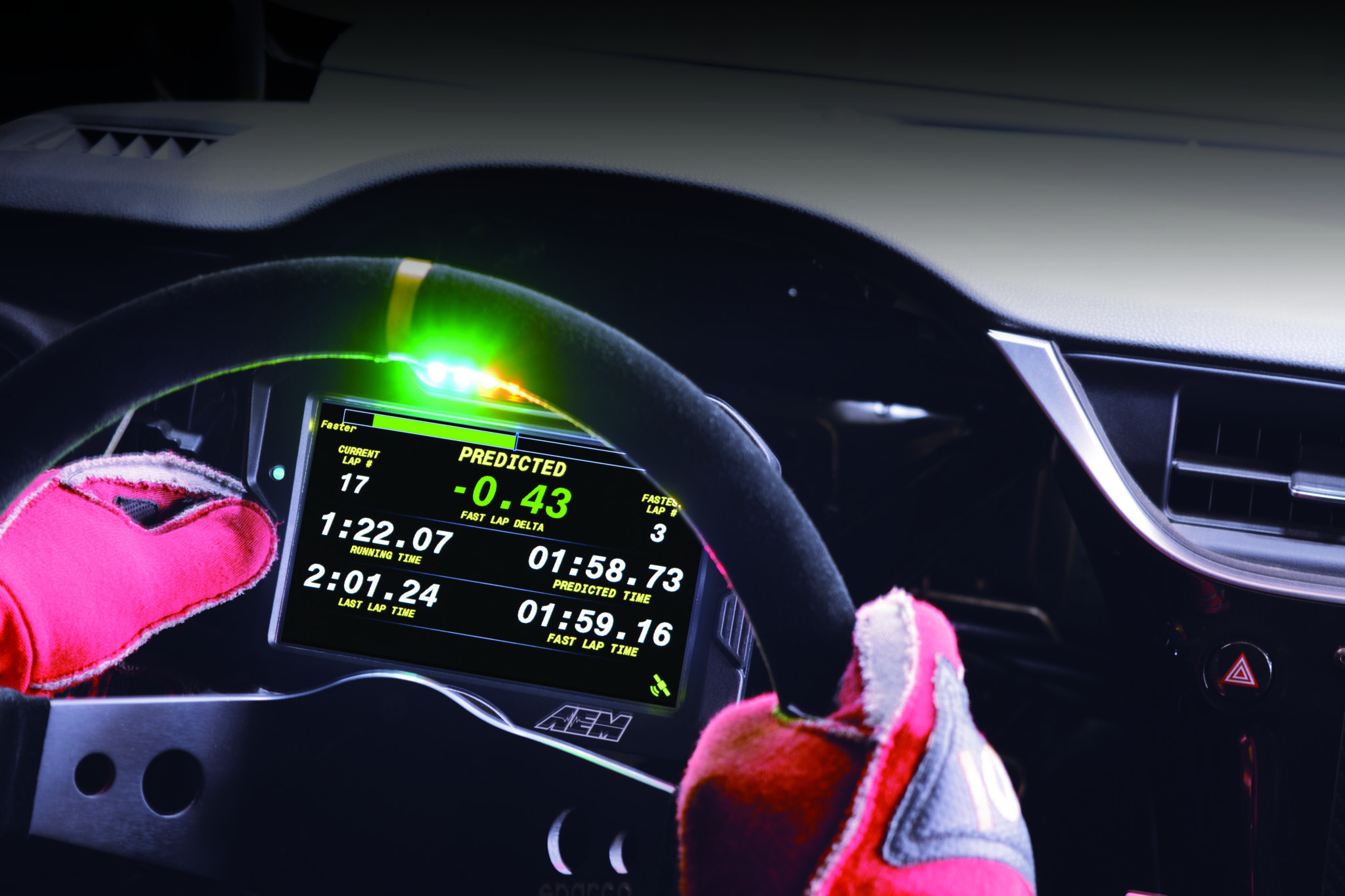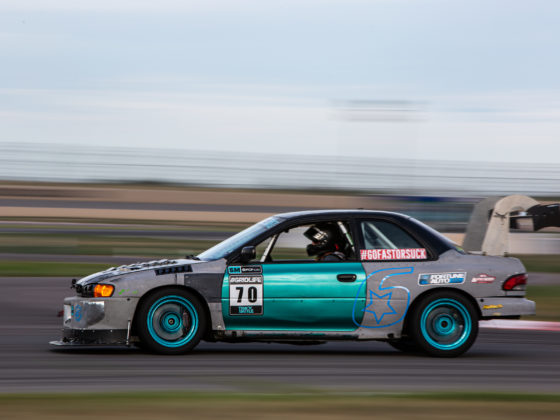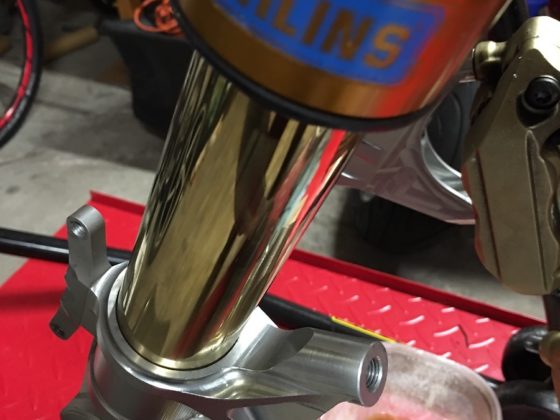Racepak brings something new and different to the table with the Vantage CL2 OBD2/EFI Data Kit. The Vantage CL2 concept acts as a hybrid between the low-cost, ease of use solution that mobile apps offer, with the benefits of dedicated hardware to pipe in as much data as possible. It plugs directly into the OBD2 port (or aftermarket EFI with an optional connector), and transmits the data via Bluetooth to your mobile device running Racepak’s D3 app. Utilizing the OBD2 data along with a dedicated GPS sensor, your mobile device then doubles as the display and data logger for timing and vehicle information. The big advantage here is that users can upload and stream this data through Racepak’s cloud service, allowing you to review it later and for others to view the data feed live on their mobile devices. Starting at $286.95, the Vantage CL2 provides one of the most powerful means of data analysis simply on your smartphone.
Dashloggers
If you require a data system that can fully mate with the inner workings of your car, logging and displaying highly detailed information, you’re probably aiming for the best of the best. Dashes and dashloggers have come a long way in the past decade. They’re getting packed with more features than ever before, bringing pro-grade hardware to your beater track car. The technology is advancing, while also becoming more affordable.
At this level, the hardware can pull data from a long list of ECUs whether you’re running factory or aftermarket equipment. You’ll have the ability to add more sensors than you’d know what to do with, from engine vitals to suspension and brake information. The only limit is how many sensors you’re willing to purchase and wire to the system. Need an infrared reading on tire temperatures while you’re on track? How about shock travel rates and distance? Or perhaps you need to figure out exactly how much wheelspin you’re putting down when coming off slow corners? Most of these sorts of channels and calculations are already mapped out in the manufacturer’s software for you, and you have the ability to program your own math channels if needed. In most dashloggers, the data read speeds are quick and accurate, and the real estate offered on the display allows for endless customization options. Many dashloggers even include outputs that can control external systems like lights, pumps, or fans. Most of them feature customizable alarms and shift lights, some even have direct compatibility for onboard cameras.
Most Motorsports-oriented dashloggers range between $2,000 to $5,000, but this number can easily go up with additional sensors. When counting the hardware plus labor involved, this option is not for the faint of heart. You’ll need to find a way to mount the dash, plus wire up the sensors and configure the software and hardware to play together nicely.
AEM Performance Electronics CD Carbon Dash (5″ and 7″)

The CD Carbon Dash from AEM Performance Electronics is offered in 5″ and 7″ screen configurations in a carbon fiber composite enclosure, making them ultra-lightweight while still providing plenty of screen real estate. One of the highlight themes of the CD Carbon Dash is its versatility to fit any users’ needs. It’s offered in two types of enclosure styles to provide either integrated buttons with a shade hood or a flat panel design with external buttons. It can store over 24 hours of data, with the ability to log thousands of channels of data with transfer speeds up to 1KHz/second. AEM Performance Electronics offer a range of adapter harnesses (including a quick and easy OBDII adapter), plus a massive list of CAN-based devices that the CD Carbon Dash will play nicely with. Adding to its versatility, this dash’s display is completely customizable, meaning you can use the manufacturer’s pre-made items or create your own from scratch. Display whatever you want, in any size, any color, any sort of gauge, and any text, based on whatever triggers you choose. The data is analyzed on the free AEMdata software, which continues the theme of versatility. It can be as simple or as detailed as you want to make it, to fine tune your car setup or your driving technique. MSRP starts at $1,054.50, also making it one of the most affordable dashloggers you can get.

AiM has become a common standard in the grassroots racing world, offering serious bang for the buck with its product lines. The past few years have introduced color dash displays and loggers across the board, and AiM is certainly no slouch in this department. The current lineup of MXS (5″), MXP (6″), and MXG (7″) dashloggers offer a lot of customization options, although mostly limited by AiM’s own preset themes. While some users may want a little more freedom in fine-tuning the display options, these limitations also prevent you from screwing things up. This is where the primary advantages of AiM’s ecosystem come into play. There is a lot of modularity here with plug-and-play expansions for additional sensors, video, and input/output options all available from AiM. It also comes with the unique advantage of allowing users to customize the dashlogger and to download data over a Wi-Fi connection, which means you can download data within wireless range from behind the pit wall and never even touch the car. Data can then be reviewed on AiM’s Race Studio Analysis software. MSRP starts at $2,299.00.




5 comments
I’m very interested in the Fueltech FT series Dash/datalogger/ECUs, I like the idea of an all-in-one system both for the simplicity and for the ease of installation/debugging/tuning. The only thing holding me back is support, its a Brazilian company with little representation or support outside south america. If AiM offered a similar product I would buy it in a heartbeat.
The secret to being a great driver has much more to do with understanding slip angles. When you understand how tires work to produce maximum grip, then you can start improving your laptimes.
The key, is understanding what ‘being on the limit’ really means. First, you must know what the best temps are for your tire. Make sure that temp is evenly distributed across all tires, and then you must drive in a way to keep the tires at those temps without exceeding high/low limits.
After that, you must understand that tires produce maximum traction dependent on the normal force (weight+downforce), ideally you want maximum downforce, at all speeds, and to distribute weight to minimize CoG, and polar moments (of course, it depends on FWD, RWD, AWD.)
Considering all those factors together, you also need to have the courage to drive all tires at the edge of the traction circle, determined by slip angle. That’s why Anti-Ackerman works for race tires, and also very slight drift angles (the rear tires need slip angles 3-5 degrees to generate maximum cornering force.)
In summation, you need to understand all these concepts intuitively (like Senna) AND you must be willing to drive at those limits. It’s very rare that somebody can put all those elements together, but when they do, the driver’s ability becomes far greater than the sum of the parts.
Dont forget https://www.autosportlabs.com/
RACECAR DEVELOPMENT NOTES
The list below should read as a development schedule. So, it starts with the basic stuff, and gets more advanced. I do believe that you must first build a solid chassis before you start on Engine/Horsepower modifications, so that’s how the list is arranged.
Driver Essentials (Before Vehicle Modification)
Read as much as possible on driving and vehicle development before modifying your vehicle.
Develop goals/targets for vehicle depending on street, track, or full race goals.
Steering Wheel (Leather, Aftermarket Race Wheel, etc.)
Race Pedals (Optimize for heel/toe shifting.)
Driving Gloves/Shoes/Sunglasses (Improved feel and performance while driving.)
Race Seat/Race Harness (Depending on street vs. track vs. full race)
Blacked Out Dash/Felt/Flocking (To reduce glare.)
Aftermarket Instrumentation (Tachometer, Oil Pressure Gauge, Water Temp Gauge, Boost Gauge, OBD2 ELM App (DashCommand, etc.))
CHASSIS/SUSPENSION DEVELOPMENT ORDER
1. Chassis Geometry (Street Car vs. Track Car)
(Obviously, you can’t change all of these variables, so they should be considered before you purchase a particular vehicle platform.)
Track (Wide track for maximum cornering grip vs. Narrow track for lower aero drag to maximize top speed.)
Wheelbase (High speed racing (HPDE & Drag Racing) vs. Low speed racing (AutoX))
Ride Height (Necessary wheel travel dependent on road surface variation.)
Suspension Type (Optimization of MacPherson vs. Double Wishbone vs. Multilink)
2. Mass Optimization (Reduction, Relocation, CoG & Polar Moment)
Unnecessary Part Deletion, Hole Drilling, Mass Relocation (Battery, Ancillary parts)
CoG & Polar Moment Optimization (Moving mass closer to the ground plane and reducing/increasing polar moment depending on racing category. (Reduce polar moment on AutoX, Time Attack, but increase on Drift.))
Part Material Replacement (Lexan Windows, Aluminum, Titanium, Carbon, etc.)
3. Chassis Stiffness (Dependent on Tire Grip/Spring Rates)
Bushings vs. Spherical Bearings (Street vs. Track)
Strut Tower Bars (Strut bars should be light and stiff, and doubled bolted to handle bending/moment loads.)
Custom Structural Bracing (Triangulation between frame members.)
4. Spring Rates (Dependent on Street vs. Race Tire)
Spring Rates Depends on FWD, AWD, RWD
Corner Weighting (Balance Optimization)
Air Springs (Non-Linear spring rate needs specific damper tuning)
Progressive Coils or Tender Springs (Dependent on street vs. track surfaces.)
Spring Preload Optimization (Street vs. Track)
5. Dampers
Twintube vs. Monotube (Monotubes are better for low travel suspensions considering higher volume fluid displacment for given displacement.)
Fixed vs. Adjustable (Street vs. Track Car)
Electrically Controlled/Dynamic Damping (Ideal for street cars that see various road surfaces.)
6. Tires & Wheels & Alignment
Street Rubber (Grip vs. All-Weather Performance)
Race Slicks (Heat Cycling, Tire Stretch, )
Race Wheels (Forged vs. Spin Casting, Offset, Width)
Street Wheels (Lightweight vs. Durability)
Slip Angle Optimization (Sidewall Compliance vs. Ultimate Grip & Steering Response)
Tire Temperature Optimization (Possibly necessitating staggered tire sizes.)
Camber (Dependent on Suspension Type)
Toe (Toe-in for vehicle stability, Toe-out for rotation)
7. Braking System
Upgraded Pads (Street vs. Track)
Upgraded Rotors (Premium Damped Iron, Electroplated, etc.)
Brake Master Cylinder Brace
Aftermarket Stainless Steel Brake Lines
Aftermarket Calipers (Dual Caliper Sliding Piston, Fixed Caliper 4-Piston, etc.)
High Temp DOT5 Racing Brake Fluid
Aftermarket Two-Piece Floating Rotors (Slotted, Crossdrilled, Carbon, Carbon-Ceramic, etc.)
Aftermarket Race Pads (High Temp. Pads for aftermarket rotors.)
8. Aerodynamics
Stock Sheet Metal Optimization (Front first/Rear last due to boundary layer separation: Hood Vents, Plugging Unnecessary Bumper Openings, Reducing Panel Gaps, Fender Cutouts, etc.)
Front Airdam/Splitter (Street vs. Track)
Custom Wheel Strakes/Air Curtains (To reduce airflow into wheel well.)
Aftermarket Body Kit (Widebody, Aero Optimized, etc.)
Aftermarket Rear Wing
Aftermarket/Custom Front and/or Rear Diffuser
Aftermarket Vortex Generators
ENGINE/TRANSMISSION/DIFFERENTIAL DEVELOPMENT ORDER
(This list is highly dependent on NA, Turbo/SC)
1. Engine (Essential Maintenance)
Cam Belts, Water Pump, Engine Bearings, Valve Lash Adjustment, etc.
2. Oil System
Premium Synthetic Oil & Filter
Cerratech, LubroMoly Oil Additives
Oil Plug Magnet + Neodymium Magnets (On oil filter.)
Oil Canister Hose Clamps (To reduce canister wall flex under high oil pressure.)
3. Thermal Management
Coolant Flush/Replacement
Coolant Additives (Water Wetter)
4. Engine Mounts
Hard Rubber (Street), Polyurethane (Track), Aluminum (Extreme Race)
5. Exhaust System
Aftermarket /Custom Catback Exhaust (Mild Steel vs. SS vs. Ti)
Headers (4-2-1 vs. 4-1, Exhaust Wrap)
Race Pipe and/or Race Catalytic Converter
6. Intake System
Flat Panel Type vs. Cone Air Filter (Street vs. Track)
Aftermarket Intake System (Short Ram (+HP) vs. Cold Air (+TQ))
Race Pipe and/or Race Catalytic Converter
Intake Manifold Spacer (To reduce heat xfer from the head to the manifold
7. Fuel System
Fuel Pump Rewire (To maximize voltage at pump.)
Fuel Pump Upgrade (Dependent on NA or Turbo/Supercharged
Fuel Rail (Turbo/SC)
Full Fuel System Replumbing (Turbo/SC)
8. ECU Tuning
ECU Reflash/Chipped
Aftermarket ECU (Necessitating Engine Dyno testing)
9. Transmission / Differential (HP Dependent)
Upgraded Shifter (Poly/Bronze Bushings, Short Shift vs. Long Shift (Street vs. Track))
Synthetic Transmission/Differential Fluid
Aftermarket Clutch (Street vs. Track, HP Dependent)
Aftermarket Flywheel (Street vs. Track)
Transmission/Differential Cooler
10. Engine Internals
Aftermarket Oil Pump / Oil Pan
Windage Tray / Improved Oil Scavenging / Full Race Dry Sump
Aftermarket Rod Bolts/Rods
Aftermarket Pistons/Pin/Rings
Aftermarket Camshafts/Springs/Retainers
Aftermarket Valves/Valve Guides
Race Porting/Polishing
Engine Blueprinting/Deburring/Balancing
Aftermarket Engine Sleeves/Crankshaft
11. Transmission/Driveline (Advanced Modifications)
Optimized Gearing (High Speed vs. Torque)
Aftermarket Differential (Viscous, Clutch, Torsen)
Aftermarket Driveshaft (Aluminum, Carbon)
Race Type Transmission (Sequential Shift, etc.)
I can’t seem to find the data analysis article, maybe I’m not looking in the right place though.